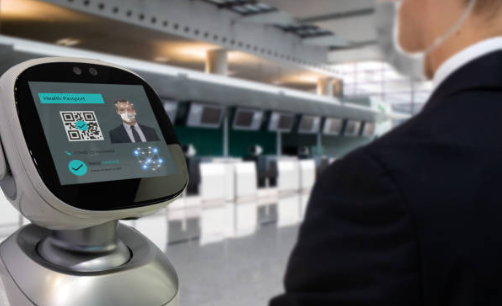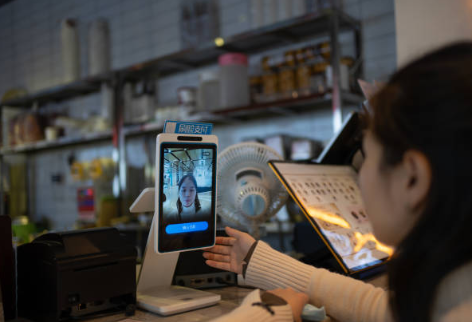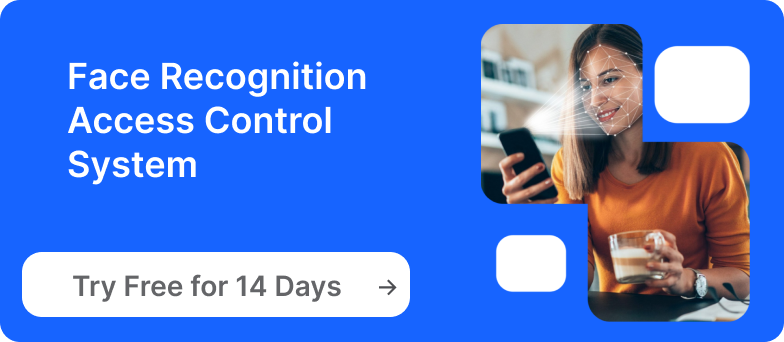
Facial Recognition for Security and Video Surveillance
Imagine a busy airport terminal, where thousands of travelers pass through every day, each with their own unique story and purpose. In this dynamic environment, security is of paramount importance. Here is where facial recognition technology steps into the spotlight.
Consider a scenario where an individual of interest is flagged by law enforcement agencies for suspicious activity. It could be difficult to track this person in the crowds using conventional surveillance techniques. However, with facial recognition technology, the process becomes remarkably streamlined.
As the individual enters the airport terminal, cameras placed in strategic locations capture their facial image in real-time. The facial recognition system immediately analyzes the key facial features and compares them against a database of known persons of interest. Within seconds, a match is found, and an alert is sent to security personnel.
Indeed, facial recognition technology has revolutionized the field of security and video surveillance by providing unmatched precision in person identification. In this blog post, we will explore the fundamentals of facial recognition, its benefits for security applications, its working mechanism, and highlight Luxand.cloud facial recognition access control system as a powerful tool.
What is Facial Recognition?

Facial recognition is a biometric technology that identifies or verifies individuals based on their unique facial features. In a technical sense, facial recognition functions by examining and contrasting patterns of facial features that are extracted from pictures or video frames. These patterns typically include the distances between key facial landmarks such as the eyes, nose, and mouth, as well as the overall shape and contours of the face.
Putting it simply, facial recognition is essentially a digital take on the ability to identify a person’s face in a crowd. Facial recognition technology uses algorithms to examine and identify particular features that are specific to each individual, much as we can identify different people based solely on the features of their faces. It gives computers the same ability to “see” and identify faces much like humans do, but with the speed and precision of machine learning.
Facial recognition is being used for purposes far beyond airport security. It is now being used in lock screen technology. You just need to glance at your phone and it opens as if by magic, saving you from having to search for your passcode or struggle to remember your pattern lock.
When you set up facial recognition on your smartphone, you actually teach your device to recognize your face. Your phone camera records a sequence of images as you register your face, collecting various viewpoints and facial expressions. It is like building a digital blueprint of your facial features.
Your phone now activates its front-facing camera whenever you try to unlock it. It looks over your face, identifying important features including the distance between your eyes, the curve of your nose, and the angles of your jaw. The blueprint that is kept in the memory of your phone is then compared with this data. If the features captured by the camera match up with the stored blueprint within a certain margin of error (which is usually pretty tiny), your phone unlocks faster than you can say “cheese.”
So, when you unlock your smartphone using facial recognition or when security systems identify a person of interest in a surveillance video, it’s all thanks to facial recognition technology analyzing the unique features of a person’s face and matching them against stored data.
Benefits of Using Facial Recognition for Security
The range of benefits of facial recognition technology has expanded greatly in recent years. This is what facial recognition offers to its users:
Increased Security and Access Control
Facial recognition enhances security by providing an additional layer of authentication beyond traditional methods such as passwords or keycards. This ensures that only authorized individuals can gain access to restricted areas.
This can help airports and border crossings a lot. Through prompt identity verification against databases containing known threats or watchlists, authorities can detect potential security issues and take necessary measures to guarantee public safety.
Improved Investigation and Crime Prevention
Facial recognition technology allows security systems to instantly identify suspects or people of interest, assisting law authorities in their investigations and deterring criminal activity.
Consider the following hypothetical situation: a jewelry store robbery. The perpetrator makes off big collection of priceless stones and disappears into the urban maze. However, every important detail has been filmed by the neighboring cameras outfitted with facial recognition software. The investigators upload the footage to their facial recognition system. In a matter of moments, the technology matches facial traits to large databases of known criminals. Once the match is found, officers can quickly locate the suspect, preventing further crimes.
Reduced False Alarms
Unlike traditional motion detection systems that trigger alarms for any movement, facial recognition systems can distinguish between authorized personnel and intruders, reducing false alarms and minimizing unnecessary disruptions.
Imagine that you are sound asleep when suddenly your home security system blares to life. You rush to investigate, only to find that it was just a false alarm triggered by a stray cat. With facial recognition capabilities, your security system will be able to distinguish between the your family members and the potential intruders. Your security system becomes smarter and more discerning, reducing false alarms caused by passing cars or a curious raccoon.
These examples illustrate the diverse range of benefits that facial recognition technology offers. From increased security to reduced false alarms, facial recognition has the potential to revolutionize various industries and sectors.
Applications of Facial Recognition in Security

Now, let’s focus on the high-tech applications of this game-changing technology across the three key domains: home security systems, video surveillance systems, and access control systems.
Home Security Systems
With facial recognition-enabled home security systems, your face becomes the ultimate key to safety. Picture this: you stroll up to your front door after a long day, and your home security system instantly recognizes your face, granting you seamless entry. Besides, your security system can distinguish between friend and foe, sounding the alarm at the sight of any unfamiliar faces.
Video Surveillance Systems
Imagine a bustling city street lined with surveillance cameras, each equipped with facial recognition capabilities. These cameras scan faces in real-time, identifying individuals of interest and flagging potential threats. From identifying suspects in criminal investigations to tracking the movements of known persons of interest, facial recognition technology transforms video surveillance systems into powerful crime-fighting tools.
Access Control Systems
When it comes to controlling access to secure areas, traditional methods like keycards and PIN codes are a thing of the past. With facial recognition-enabled access, your face becomes the key that unlocks the door to restricted areas. Whether it is a high-security government facility or a top-secret research lab, facial recognition technology ensures that only authorized personnel gain entry.
How Facial Recognition Works in Security Systems
Now, let’s have a look at the three key stages of facial recognition technology: facial capture and detection, facial feature extraction, and facial matching and comparison.
Facial Capture and Detection
The first step of facial recognition technology is facial capture and detection. To enable this, cameras are positioned strategically to capture faces. But these are special cameras: they are equipped with advanced sensors and algorithms that can detect faces with pinpoint accuracy. In addition, they can do it in different surroundings, from crowded city streets to dimly lit hallways, laying the foundation for the next step.
Facial Feature Extraction
Now that we have captured the subjects on cameras, it’s time for facial feature extraction. The digital algorithms meticulously “dissect” each facial image into its constituent parts—eyes, nose, mouth, and all the other intricate details that make up a face. The algorithms analyze the facial landmarks and extract the key features such as the curvature of a smile, the angle of a nose, etc.
Facial Matching and Comparison
Last but certainly not least, we arrive at facial matching and comparison. Armed with retrieved facial data, the algorithms start looking for matches in the database of digital faces. With lightning-fast processing power, our facial recognition system compares extracted facial features against a database of known faces. And when a match is found, the system alerts the security personnel and ensures that the right people gain access to the right places.
So the next time you pass by a security camera, remember the incredible feats of technology happening behind the scenes, keeping us safe and secure in an increasingly complex world.
Facial Recognition Accuracy in Security Systems. Factors Affecting Accuracy

Advances in deep learning and artificial intelligence have significantly improved the accuracy and reliability of facial recognition technology in recent years. Though, still, the accuracy of facial recognition systems depends on various factors, including the quality of images, lighting conditions, pose variations, and the effectiveness of the underlying algorithms.
So, let’s uncover the factors that can impact the performance of facial recognition accuracy.
Image Quality
Image quality plays a pivotal role in the accuracy of facial recognition systems. Grainy, low-resolution images captured in less-than-ideal lighting conditions can lead to errors and false positives.
Environmental Factors
Harsh lighting conditions, dynamic backgrounds, and other environmental factors can impact accuracy. Glare from the sun, shadows cast by nearby objects, and even inclement weather can distort facial features and impede recognition accuracy.
Variability in Facial Expressions and Poses
Unique facial expressions and poses, such as a subtle smirk, can vary from person to person and even moment to moment. In addition, there are different poses — head tilts, angles, and rotations that can be a significant problem, requiring sophisticated algorithms to adapt and overcome the challenge.
Diversity in Demographics
Facial recognition systems trained on a homogeneous dataset may struggle to accurately identify individuals from diverse demographics. Factors such as age, gender, ethnicity, and facial hair can introduce biases and disparities in recognition performance.
The accuracy of facial recognition systems depends on a multitude of factors, from image quality and environmental conditions to variability in facial expressions and demographics. By understanding and addressing these challenges, we can achieve a more accurate and reliable facial recognition technology that enhances security.
Luxand.cloud Facial Recognition Access Control System
How Luxand.cloud Access Control System Works
Luxand.cloud offers a sophisticated Access Control System that leverages facial recognition technology to provide secure and efficient access management. Here's a detailed overview of how the Luxand.cloud Access Control System works:
In the first step, a person takes a selfie and uploads it to the system. The selfie is subsequently safely saved to the system's database.
When an individual approaches the access point (door, gate, etc.), the camera captures their face. The system extracts facial features and verifies liveness, generating a new face template. This new template is then compared to all the stored templates in the database.
If the new template closely matches an authorized one, access is granted. If no close match is found, access is denied, and an alert may be triggered based on the system settings.

Luxand.cloud Access Control System Use Cases
Luxand.cloud access control system has versatile applications across various industries. Here are some use cases.
Office Buildings
Luxand.cloud access control software can be seamlessly incorporated into various office building operations, managing access to entrances, exits, and restricted areas to prevent unauthorized entry. It simplifies tracking employee access and verifying work hours. Additionally, the software enhances security by restricting access to employee areas such as break rooms, locker rooms, and sensitive storage areas, thereby protecting sensitive information and safeguarding company assets from theft.
Educational Institutions
By integrating facial recognition technology at key access points, the system significantly enhances campus security. Unauthorized access attempts trigger immediate alerts, enabling swift action by security personnel. This proactive approach helps maintain a safe environment for all campus residents. Moreover, the system maintains detailed logs of all access events, including date, time, user identity, and access point. These logs are essential for audits, investigations, and compliance purposes, providing a clear record of movements within the institution.
Healthcare Facilities
Managing patient and visitor access is simplified with Luxand.cloud. Patients can be granted access to specific areas based on their treatment needs, and visitors can be issued temporary access to designated zones. This ensures that only authorized individuals can enter certain parts of the facility, enhancing overall safety and security. Plus, security personnel benefit from real-time monitoring capabilities provided by a centralized dashboard. This feature allows for continuous oversight of access activities throughout the healthcare facility. In the event of an unauthorized access attempt, the system can trigger immediate alerts, enabling quick response to potential security threats.
Conclusion
Facial recognition technology has become an indispensable tool in the field of security and video surveillance, providing unparalleled accuracy and dependability in the identification and verification of people. Facial recognition has many uses and advantages, and it has the potential to change security in the future by protecting property and improving public safety.
Leveraging advanced technologies like Luxand.cloud's facial recognition access control system offers a range of benefits that can improve security, convenience, and efficiency across various applications.
